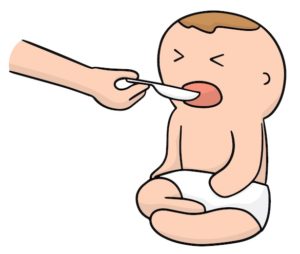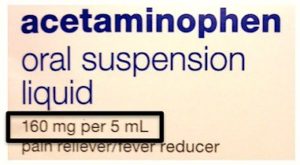Doctors’ Notes
BackFever, Pain Relief, & Allergy Dosing
Your young child is cranky and warm. You take a temperature, and you see it’s over 100.4. So you head to the medicine cabinet, look at the box, and see: Under 2 years – Ask a Doctor.
 Now what?
Now what?
Well, have no fear! This note gives you all the handy dosing information you need for for Acetaminophen (brand names Tylenol, Little Fevers, etc.) and Ibuprofen (brand names Motrin, Advil etc.).
We also include dosing tables for Cetirizine (Zyrtec) and Loratadine (Claritin), over-the-counter medicines to help control allergy symptoms.
Picking the Right Concentration
Finding the right bottle of medication can be a little tricky. There are usually a million choices, and it can take a while to sort through all the options. Bottles are generally sorted into “Infant” and “Child” liquids. The infant forms usually have a dropper, the child forms a cup. To use a dosing chart (see links below), you first need to know the concentration of the bottle.
 The concentration information is usually listed on the front of the box. (For an example, see the image included here.)
The concentration information is usually listed on the front of the box. (For an example, see the image included here.)
This means that 5 milliliters of this liquid contains 160 milligrams of the medicine. Luckily, infants’ acetaminophen and children’s acetaminophen both have the same concentration (160mg / 5mL), so the dose is the same no matter which product you use. However, the concentration of infants’ ibuprofen and children’s is still different, so it’s important to double check the concentration of the product before you use the dosing tables below.
What Should I Use to Give the Dose?
The best thing to do is to use the dropper or cup included with the medication. If you lose the dropper, you can buy a replacement at a pharmacy. Just be sure you give the correct amount according to the dosing table (see links below) .
Wait… What About Benadryl?
For many years, pediatricians have recommended using diphenhydramine (Benadryl) as the first line treatment for hives or allergy symptoms. As common as this medication is, it has many side effects, including significant drowsiness, confusion, temporary blurred vision, and dry mouth. Recent studies show that “next generation” allergy medicines such as cetirizine (Zyrtec) and loratadine (Claritin) are safer and more effective in the treatment of hives and allergies when compared to Benadryl. These medicines also work faster and last longer in the body, so you only need to give them once a day, which means less medicine for your little one!
To learn more about the differences, and a lot more information about treating and identifying allergies, listen to our Kids + Podcast episode on Allergies & Misinformation.
A Few More Important Points
1. If your child is less than 2 months old and has a rectal temperature higher than 100.4, call the office before going any further.
2. Be sure to keep track of the times you give each dose. Acetaminophen can be given up to every 4-6 hours (maximum 5 doses per 24 hours, ibuprofen every 6-8 hours (maximum 4 doses per 24 hours). Be sure to watch the time between doses, because young children can overdose if doses are given too close together.
3. Do not use Ibuprofen for children under 6 months of age. Young babies aren’t able to clear the drug from their systems as well as older infants and children.
4. Acetaminophen rectal suppositories are available for children who are unable to take oral medications due to vomiting. However, if your child is sick to the point that he/she can’t keep anything down and also has a fever, please call the office.
5. We generally do not recommend using more than one allergy medicine at a time (for example giving Zyrtec in the morning and Claritin in the afternoon). If you have concerns that the allergy medicine you’re using isn’t fully controlling your child’s allergy symptoms, please call the office.
Fever/Pain Dosage Tables by Weight
You can use these charts online, or print them out for easy reference:
ACETAMINOPHEN (Tylenol)
IBUPROFEN (Motrin/Advil)
Allergy Symptom Dosage Tables by Weight
You can use these charts online, or print them out for easy reference:
CETIRIZINE (Zyrtec)
LORATADINE (Claritin)
As always, if you have any questions or concerns, just give us a call in the office anytime.